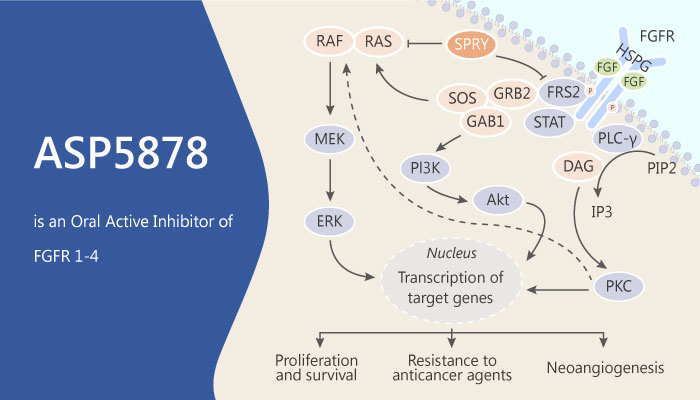Hepatocellular carcinoma represents an aggressive cancer with poor prognosis. Fibroblast growth factor 19, a member of the fibroblast growth factor family, is a ligand for fibroblast growth factor receptor 4. In addition, it plays a crucial role in the progression of hepatocellular carcinoma.
A study from Takashi Futami discovered and identified a FGFR 1, 2, 3, and 4 inhibitor ASP5878. In the study, the authors verified the function of ASP5878 both in vitro and in vivo.
Firstly, ASP5878 exhibits IC50 values of 0.47 nM, 0.6 nM, 0.74 nM and 3.5 nM for FGFR 1, 2, 3, and 4 kinase activity, respectively.

In vitro, HuH-7, Hep3B2.1-7, and JHH-7 cell lines exhibited potent sensitivity to ASP5878, with IC50 values of 27, 8.5, and 21 nmol/L, respectively. The growth inhibition rate of HLF was 64% and those of other ASP5878-sensitive cell lines were higher than 95% at 1000 nM. Additionally, ASP5878 inhibits FGFR4 phosphorylation in a concentration-dependent manner. ASP5878 treatment results in the suppression of phosphorylation, mobility shift of FRS2, and suppression of ERK phosphorylation.
In vivo, in four-week-old male nude mice (CAnN.Cg-Foxn1nu/CrlCrlj [nu/nu]) (Hep3B2.1-7 cells inoculated subcutaneously), ASP5878 induced tumor regression by 9% and 88% at 1 and 3 mg/kg, respectively, without affecting the body weight for 14 days. ASP5878 also induced the suppression of FGFR4 phosphorylation, mobility shift of FRS2, and suppression of ERK phosphorylation. And in HCC orthotopic xenograft mouse model, ASP5878 exhibited a lower tumor burden than vehicle- and sorafenibtreated mice. ASP5878 also induced sustained tumor regression without tumor regrowth. To conclude, ASP5878 shows antitumor activity in a Hep3B2.1-7 subcutaneous xenograft and HCC orthotopic xenograft mouse model. Additionally, ASP5878 induces shrinkage of FGF19-expressing HCC xenograft model.